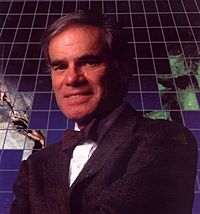Martin Rodbell facts for kids
Quick facts for kids
Martin Rodbell
|
|
|---|---|

Rodbell in 1994
|
|
| Born | December 1, 1925 |
| Died | December 7, 1998 (aged 73) |
| Nationality | American |
| Alma mater | Johns Hopkins University University of Washington |
| Known for | G-proteins signal transduction |
| Spouse(s) | Barbara Charlotte Ledermann (m. 1950; 4 children) |
| Relatives | Sanne Ledermann (sister-in-law) |
| Awards | Nobel Prize in Physiology or Medicine (1994) Gairdner Foundation International Award (1984) Richard Lounsbery Award (1987) |
| Scientific career | |
| Fields | Biochemist |
| Institutions | National Institute of Health Duke University University of North Carolina at Chapel Hill |
Martin Rodbell (December 1, 1925 – December 7, 1998) was an American scientist. He was a biochemist, which means he studied the chemistry of living things. He also studied endocrinology, which is about hormones and glands. Rodbell is famous for discovering something called G-proteins. These proteins help cells talk to each other.
In 1994, he won the Nobel Prize in Physiology or Medicine. He shared it with Alfred G. Gilman. They won for their discovery of G-proteins and how these proteins help cells send signals.
Contents
The Life of Martin Rodbell
Martin Rodbell was born in Baltimore, Maryland, in 1925. His family was Jewish. After finishing high school at Baltimore City College, he went to Johns Hopkins University in 1943. He was interested in biology and French literature.
In 1944, his studies were paused. He served in the United States Navy during World War II as a radio operator. He returned to Johns Hopkins in 1946. In 1949, he earned his bachelor's degree in biology.
In 1950, he married Barbara Charlotte Ledermann. She was a friend of Anne Frank's older sister, Margot Frank. Martin and Barbara had four children together.
Rodbell continued his education. He earned his Ph.D. in biochemistry from the University of Washington in 1954. After that, he did more research at the University of Illinois at Urbana-Champaign until 1956.
His Career in Science
In 1956, Rodbell started working as a research biochemist. He joined the National Heart Institute. This was part of the National Institutes of Health (NIH) in Bethesda, Maryland. The NIH is a big government agency that does medical research.
In 1985, Rodbell became a Scientific Director at another part of the NIH. This was the National Institute of Environmental Health Sciences. It was located in Research Triangle Park, North Carolina. He worked there until he retired in 1994.
He also taught at universities. He was a professor at Duke University from 1991 to 1998. He also taught at the University of North Carolina at Chapel Hill. Martin Rodbell passed away in Chapel Hill in 1998. He had been sick for a while.
How Cells Talk: Rodbell's Discoveries
In the 1960s, scientists started comparing cells to computers. Rodbell believed that cells process information much like computers do. He thought that individual cells were like tiny systems. These systems had three main parts:
- Discriminators: These are like the cell's "ears." They receive information from outside the cell. We now call these receptors.
- Transducers: These parts process the information. They move the signal across the cell's outer layer, called the cell membrane.
- Amplifiers: These parts make the signal stronger. They start reactions inside the cell or send the information to other cells.
The Discovery of G-Proteins
In late 1969 and early 1970, Rodbell and his team were studying a hormone called glucagon. They were looking at how glucagon affected receptors on rat liver cells. These receptors were the "discriminators" that received outside signals.
Rodbell made an important discovery. He found that a molecule called ATP (adenosine triphosphate) could stop glucagon from sticking to the cell receptor. This would make the glucagon leave the cell.
Then, he noticed something even more interesting. Tiny amounts of GTP (guanosine triphosphate) could make glucagon leave the cell almost a thousand times faster than ATP! Rodbell realized that GTP was probably the real active molecule. He figured out that the GTP he used earlier was a tiny impurity in his ATP samples.
He found that this GTP made a special protein active. This protein was called guanine nucleotide protein, or G-protein. When the G-protein became active, it caused big changes inside the cell. Rodbell suggested that this activation of the G-protein was the "second messenger" process. Another scientist, Earl Wilbur Sutherland Jr., had thought about this idea before.
In simple terms, the G-protein, activated by GTP, was the key "transducer." It was the important link between the cell's "ear" (the receptor) and the "amplifier" (the part that causes cell reactions). Later, Rodbell showed that there were other G-proteins too. These could either boost or slow down the cell's signals, sometimes at the same time. This meant that cell receptors were very smart. They could handle many different processes all at once.
Awards and Honors
Martin Rodbell received many important awards for his work:
- Nobel Prize in Physiology or Medicine (1994)
- Gairdner Foundation International Award (1984)
- Richard Lounsbery Award (1987)
- Golden Plate Award of the American Academy of Achievement (1995)
See also
 In Spanish: Martin Rodbell para niños
In Spanish: Martin Rodbell para niños
- List of Jewish Nobel laureates

